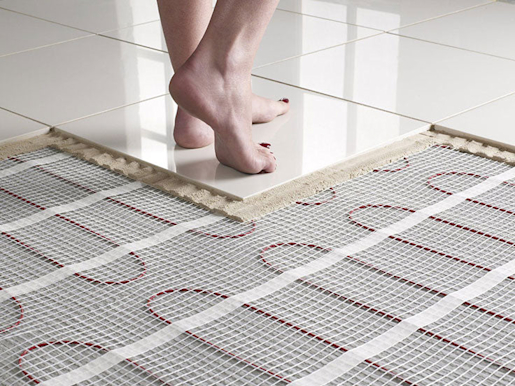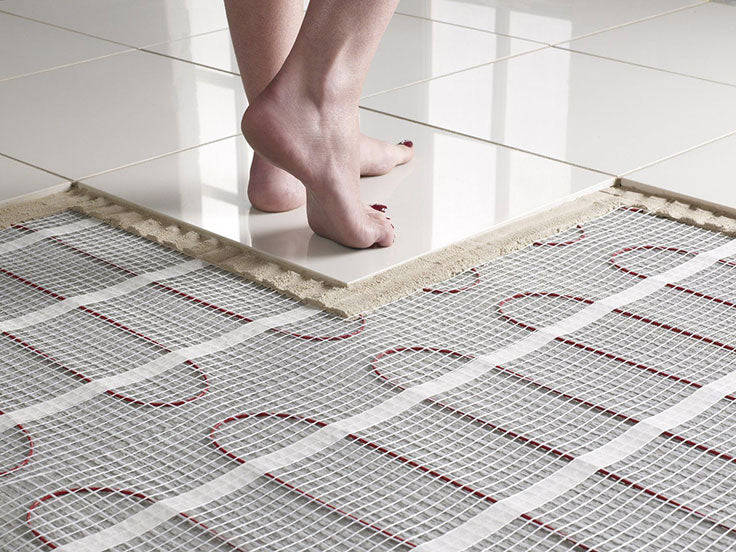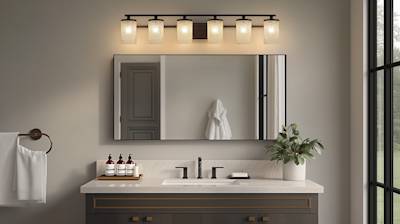Waking up to a chilly bathroom floor is the last thing you need on a cold winter morning. Besides comfort, a cold floor can be a constant reminder of how cold it is outside. However, technology has made it possible to escape this situation through a heated bathroom floor. In recent years, the popularity of heated bathroom floor systems has spiked, thanks to their many benefits. Not only does the system keep your feet warm, but it also provides an elegant look for your bathroom. This blog post delves into all you need to know about heated bathroom floors.
A Comprehensive Guide to Heated Bathroom Floors
When you mention the term 'heated bathroom floor,' many people may think about the luxurious feeling of warm tiles under their feet. A heated bathroom floor can create a spa ambiance in any bathroom setting. At its most basic, this system entails installing heating elements underneath your bathroom floor to provide the much-coveted radiant heat.
Types of Heated Bathroom Floors
There are primarily two types of heated bathroom floors: electric and hydronic. The two options vary significantly in terms of design, installation, costs, and operation. However, it's essential to choose a system that suits your preferences, needs, and budget.
Electric Heated Bathroom Floors
Electric heated bathrooms, sometimes known as radiant mats, utilize thin heating cables attached to a mesh or preformed mat underneath your bathroom floor. These systems are simple to install and maintain, making them a popular choice for homeowners.
Hydronic Heated Bathroom Floors
Hydronic systems on the other hand, use tubes of hot water below the surface of the floor. While they are more complex to install, they are an efficient way to heat larger bathroom floors. These systems are often integrated within the house’s main heating system, which helps in minimizing energy bills.
Choosing the Right Flooring Material
Even when installing a heated bathroom floor, you'll still need to determine the flooring material to use. The material you pick is of great importance as it affects the efficiency, aesthetics, and maintenance of your heated floor.
- Tile: This is the most commonly used material due to its excellent heat conduction and vast style options.
- Stone: Granite, slate, and marble are also popular options for heated floors due to their natural tendency to conduct and retain heat.
- Engineered Wood: Engineered wood floors work well with heated floor systems since they’re less susceptible to warping and shrinking.
- Laminate: Laminate flooring is suitable for heated floors due to its high durability and heat-conducting capacity. However, ensure the manufacturer approves it for use over heated floors.
Understanding the Installation Process of Heated Floors
The installation of heated bathroom floors highly depends on the system in place.
Electric Floor Heating Installation:
- Subfloor Preparation: Clean the subfloor thoroughly to ensure it's free of dust and debris.
- Insulation Layer: Install an insulation layer to enhance heating efficiency and reduce energy costs.
- Heating Element Placement: Unroll the heating mat or layout the heating cables evenly across the floor, avoiding overlaps.
- Connect to Thermostat: Wire the heating elements to the thermostat for temperature control.
- Mortar Application: Cover the heating elements with mortar or thin-set adhesive to secure them and create a level surface.
- Floor Finish Installation: Lay the chosen floor finish (like tile, stone, or laminate) over the mortar once it has set.
Hydronic Floor Heating Installation:
- Subfloor Preparation: Clean and prepare the subfloor for the installation.
- Layout Design: Plan and layout the tubing pattern to ensure even heat distribution.
- Tubing Installation: Install the tubes on the subfloor, securing them in place or embedding them in grooved panels.
- Concrete Embedding: Pour a thick layer of concrete or specialized overpour to embed the tubes, forming a solid slab.
- Connect to Water Heater: Attach the tube ends to a boiler or water heater to allow hot water circulation.
- System Testing: Test the system for leaks and ensure efficient operation.
- Floor Finish Application: Once the system is verified and the concrete has cured, apply the final flooring material.
Maintenance and Running Costs
Regular maintenance is typically minimal with heated bathroom floors. The running costs can also be relatively low, especially if you combine the system with a programmable thermostat. This ensures that the floor heating system is in use only when needed.
Installing a heated bathroom floor might be a significant investment initially, but the comfort and luxury it brings make it worth every penny. More importantly, a heated bathroom floor can increase your home's overall value. With this knowledge, you can evaluate if a heated bathroom floor is an upgrade worth considering.
Frequently Asked Questions About Heated Bathroom Floors
How do heated bathroom floors work?
Heated bathroom floors, also known as underfloor heating, work by spreading heat from the floor level, providing a comfortable temperature throughout the whole room. There are two main types of heated floors: electric and hydronic. Electric heated floors function by a network of electric wires installed under your floor surface. For hydronic heated floors, networks of water-carrying pipes release heat upwards.
Are heated bathroom floors energy efficient?
Yes, heated bathroom floors can be somewhat energy efficient. While the actual energy use will depend on the heat level and the amount of time you keep the floor heating system on, generally, heated floors distribute heat evenly in the room which can minimize the need for additional heating options. Therefore, it can contribute to saving energy over the long term.
How long do heated bathroom floors last?
On average, heated bathroom floor systems can last anywhere between 30 to 40 years if well maintained. It largely depends on the quality of installation and the type of heating mechanism used, whether electric or hydronic. However, the individual components like the thermostat may need replacing sooner.
Can I install a heated bathroom floor myself?
While it's technically possible for a keen DIY enthusiast to install a heated bathroom floor, it's usually recommended that you hire a professional. The installation is a complex process that involves electrical and potential plumbing work, so getting professional help will ensure it's installed correctly and safely.
Can heated bathroom floors go under any type of flooring?
Heated bathroom floors are quite versatile and can be installed under most styles of flooring including tiles, wood, laminate, and certain types of carpet. However, it’s crucial to understand that different types of flooring will pass through heat differently, so professional advice should be sought when choosing the flooring over your heated bathroom floor.
Do heated bathroom floors heat the room?
Heated bathroom floors do give off some heat, but it's important to remember that they are primarily designed to heat the floor surface and not the entire room. However, thanks to the heat rising, they can contribute to the overall warmth of the bathroom.
How much do heated bathroom floors cost?
The cost of heated bathroom floors can vary significantly depending on the type of system you choose (electric or hydronic), the size of your bathroom, and the complexity of the installation process. On average, you may expect the cost, including installation, to range from $10 to $20 per square foot.
Are heated bathroom floors safe?
Yes, heated bathroom floors are considered safe. They operate at relatively low temperatures and come with safety features like a grounded circuit and a GFCI (Ground Fault Circuit Interrupter). However, because they involve electrical components, it’s important that they are installed by a professional to ensure ultimate safety.
Are heated bathroom floors worth it?
This will largely depend on personal preference and your specific needs. Heated bathroom floors offer extra comfort, especially on cold mornings, and can add value to your home. However, they can also add additional costs up front, as well as some added costs to your energy bills. For some people, the luxury and comfort of stepping onto a warm floor makes it all worthwhile.
Can you retrofit a heated bathroom floor?
Yes, it is possible to retrofit a heated bathroom floor, but it can sometimes be more complex and expensive than installing it in a new building or during a renovation. It might require changing the existing flooring and potentially, the height of the floor. Therefore, it's recommended to consult with a professional to understand the potential challenges and costs.
How do you care for heated bathroom floors?
Heated bathroom floors usually require minimal maintenance once they're properly installed. Regular checks of the system’s performance, making sure that the thermostat's programmed appropriately, and addressing any potential issues as soon as they appear are enough to keep your heated bathroom floors in a fine form for many years.
Pros and Cons of Heated Bathroom Floors
PROS:
Comfort
One of the primary advantages of heated bathroom floors is the level of comfort they provide. Stepping onto a warm surface on a chilly morning or night ensures a comfortable start or end to your day. A conventional tiled floor can have a cold touch, which is significantly eliminated by heat installation:
- The warm feel of radiant heated flooring is distinctly luxurious and comforting.
- After a bath or shower, heated bathroom floors quick-dry the residual water, reducing discomfort due to wetness or moisture on the floor.
Efficient Heating
Heated bathroom floors distribute heat evenly across the room, creating a cozy and uniformly heated environment. They are effective in eliminating cold spots, common with traditional heating systems. This can contribute to a feeling of homely warmth and comfort:
- Unlike traditional radiator heaters that release the hot air, causing it to rise up, heated floors deliver heat from the bottom and distribute it evenly.
- They are often adjustable, meaning you can control the floor temperature as per personal preferences.
Energy Efficiency
Heated floors tend to be more energy-efficient than traditional heating systems, leading to reduced energy bills. Homeowners tend to appreciate this long-term cost saving:
- Heated bathroom floors use less energy than traditional radiators, as the heat produced is retained inside the floor, reducing energy wastage.
- Modern underfloor heating systems can also be paired with energy-efficient thermostats for optimal energy usage.
CONS:
High Installation Costs
One of the most significant disadvantages of heated bathroom floors is their cost. Though they offer remarkable benefits, their installation expense could be prohibitive for some homeowners:
- The cost of heated bathroom floors is considerably more than traditional tiling due to the heating materials and the labour involved in setting them up.
- Professional installation is often required to ensure the system is efficiently installed and run.
Installation Complexity
The installation of heated bathroom floors is relatively complex, requiring an experienced and knowledgeable professional for proper fitting:
- The precise and meticulous process of fitting heated bathroom floors can lead to a longer installation period.
- In case of repair or maintenance, the cost and work required to access the heating system under the tiles could be substantial.
Possible Impact on Floor Height
Installation of a heated floor system may result in a slight increase in the bathroom floor level. For some homeowners, this might be an issue:
- The increase might require slight adjustments on the bathroom door or fixtures depending on the thickness of the heating system.
- If the home is being remodeled, additional considerations like insulation might also lead to an increase in floor height.
Summary
The heated bathroom floor has become a luxury that many homeowners are aiming to incorporate into their spaces. This special feature not only provides a comfortable and cozy feeling for your feet but also helps maintain a consistent room temperature during chilly seasons. The beneficial aspects of a heated bathroom floor can make it a worthwhile home improvement project for those seeking to add extra warmth and comfort to their daily routines.
While the initial investment in a heated bathroom floor might seem significant, the long-term benefits it offers make it a valuable addition. The added heat lessens the burden on the central heating system, potentially leading to energy savings. Beyond the practical benefits, having a heated bathroom floor can significantly enhance your home's value and appeal, making it a selling point for potential buyers if you decide to put your property on the market.
Ultimately, if you wish to revamp your bathroom experience, look no further than installing a heated bathroom floor. It's a detail that enhances comfort and brings a touch of luxury to your bathroom. The warming sensation under your feet is a perfect way to spice up your home and make those cold, dreary mornings more tolerable. Splurging a little on a heated bathroom floor could be one of the best decisions you make for your home and your comfort.
About Seattle Renovation Group
Welcome to the Seattle Renovation Group! We are a premier renovation firm based in the heart of Seattle, WA. Renowned for our high-quality craftsmanship and commitment to customer satisfaction, we bring dream homes to life by providing expert renovation services. From meticulous kitchen remodels to transformative whole-house renovations, our talented team is dedicated to delivering spaces that reflect your personality and lifestyle. Dive into the home improvement journey with us, and witness your space become what you've always imagined.
Tags: heated bathroom floor, bathroom renovation, home improvement,










